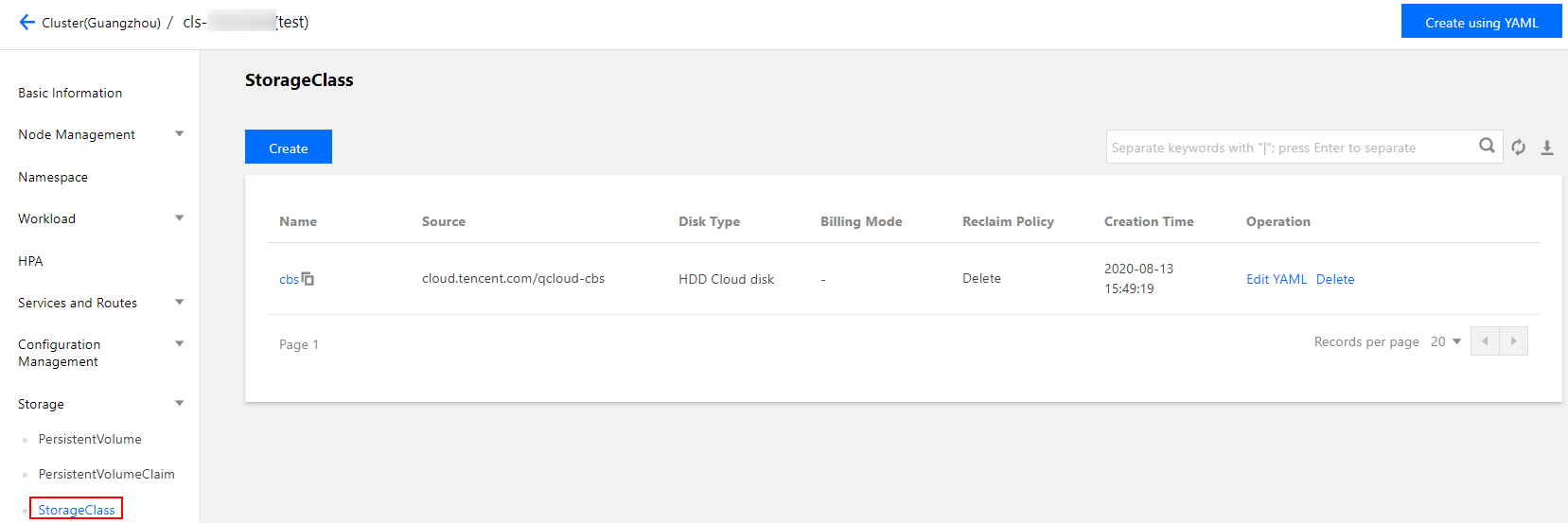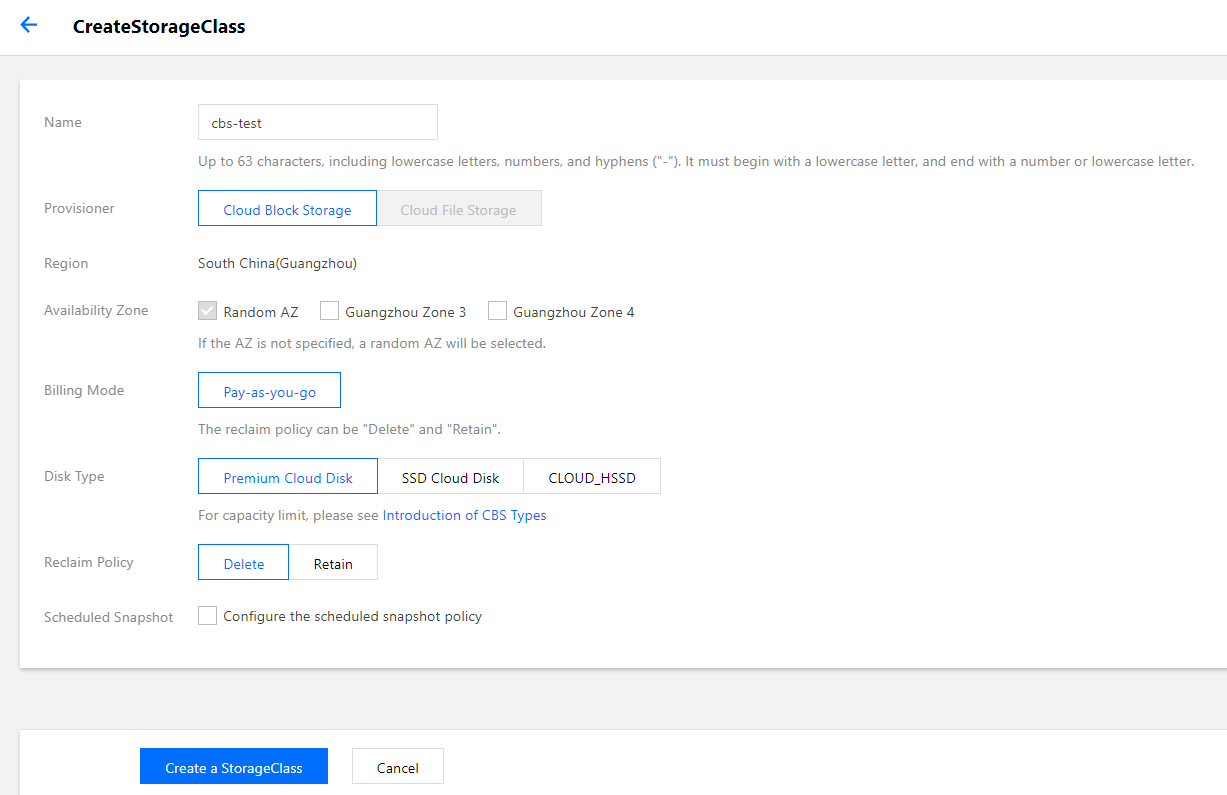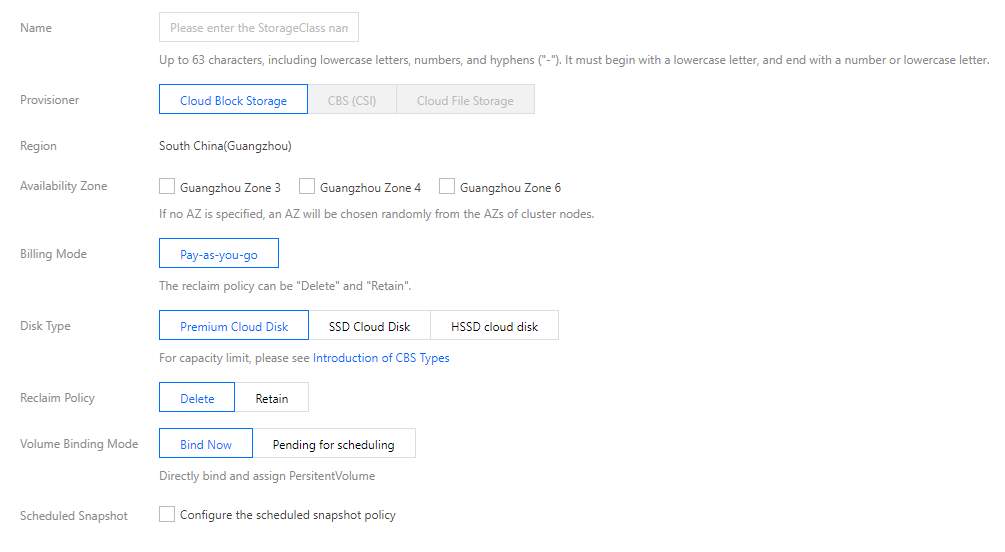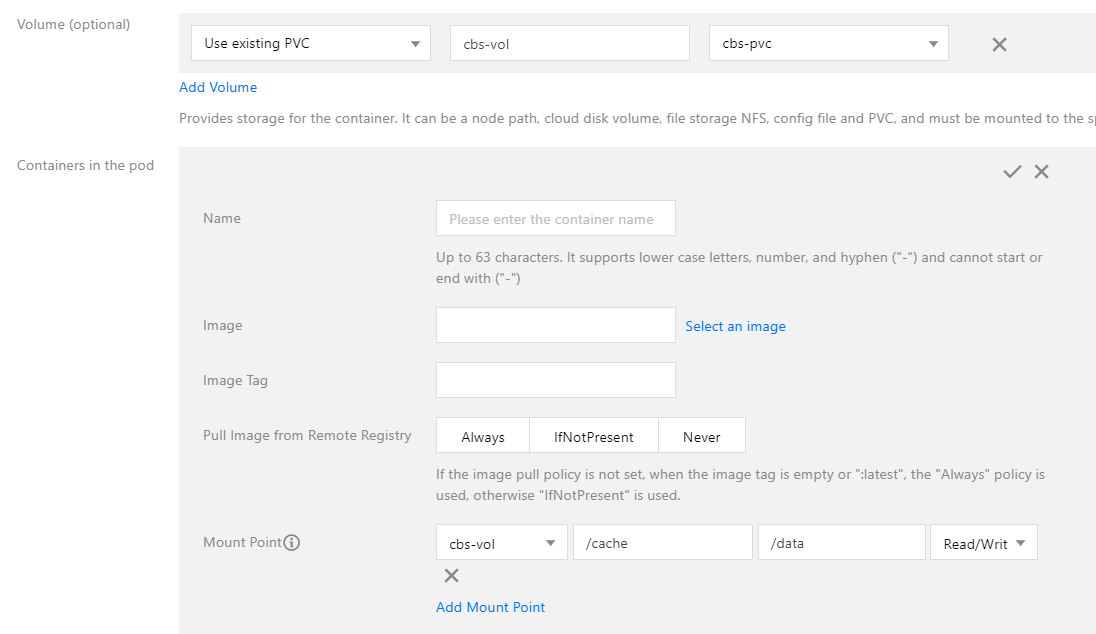- Release Notes and Announcements
- Release Notes
- Announcements
- qGPU Service Adjustment
- Version Upgrade of Master Add-On of TKE Managed Cluster
- Upgrading tke-monitor-agent
- Discontinuing TKE API 2.0
- Instructions on Cluster Resource Quota Adjustment
- Discontinuing Kubernetes v1.14 and Earlier Versions
- Deactivation of Scaling Group Feature
- Notice on TPS Discontinuation on May 16, 2022 at 10:00 (UTC +8)
- Basic Monitoring Architecture Upgrade
- Starting Charging on Managed Clusters
- Instructions on Stopping Delivering the Kubeconfig File to Nodes
- Security Vulnerability Fix Description
- Release Notes
- Product Introduction
- Purchase Guide
- Quick Start
- TKE General Cluster Guide
- TKE General Cluster Overview
- Purchase a TKE General Cluster
- High-risk Operations of Container Service
- Deploying Containerized Applications in the Cloud
- Kubernetes API Operation Guide
- Open Source Components
- Permission Management
- Cluster Management
- Cluster Overview
- Cluster Hosting Modes Introduction
- Cluster Lifecycle
- Creating a Cluster
- Deleting a Cluster
- Cluster Scaling
- Changing the Cluster Operating System
- Connecting to a Cluster
- Upgrading a Cluster
- Enabling IPVS for a Cluster
- Enabling GPU Scheduling for a Cluster
- Custom Kubernetes Component Launch Parameters
- Using KMS for Kubernetes Data Source Encryption
- Images
- Worker node introduction
- Normal Node Management
- Native Node Management
- Overview
- Purchasing Native Nodes
- Lifecycle of a Native Node
- Native Node Parameters
- Creating Native Nodes
- Deleting Native Nodes
- Self-Heal Rules
- Declarative Operation Practice
- Native Node Scaling
- In-place Pod Configuration Adjustment
- Enabling SSH Key Login for a Native Node
- Management Parameters
- Enabling Public Network Access for a Native Node
- Supernode management
- Registered Node Management
- GPU Share
- Kubernetes Object Management
- Overview
- Namespace
- Workload
- Deployment Management
- StatefulSet Management
- DaemonSet Management
- Job Management
- CronJob Management
- Setting the Resource Limit of Workload
- Setting the Scheduling Rule for a Workload
- Setting the Health Check for a Workload
- Setting the Run Command and Parameter for a Workload
- Using a Container Image in a TCR Enterprise Instance to Create a Workload
- Auto Scaling
- Configuration
- Register node management
- Service Management
- Ingress Management
- Storage Management
- Application and Add-On Feature Management Description
- Add-On Management
- Add-on Overview
- Add-On Lifecycle Management
- CBS-CSI Description
- UserGroupAccessControl
- COS-CSI
- CFS-CSI
- P2P
- OOMGuard
- TCR Introduction
- TCR Hosts Updater
- DNSAutoscaler
- NodeProblemDetectorPlus Add-on
- NodeLocalDNSCache
- Network Policy
- DynamicScheduler
- DeScheduler
- Nginx-ingress
- HPC
- Description of tke-monitor-agent
- GPU-Manager Add-on
- CFSTURBO-CSI
- tke-log-agent
- Helm Application
- Application Market
- Network Management
- Container Network Overview
- GlobalRouter Mode
- VPC-CNI Mode
- VPC-CNI Mode
- Multiple Pods with Shared ENI Mode
- Pods with Exclusive ENI Mode
- Static IP Address Mode Instructions
- Non-static IP Address Mode Instructions
- Interconnection Between VPC-CNI and Other Cloud Resources/IDC Resources
- Security Group of VPC-CNI Mode
- Instructions on Binding an EIP to a Pod
- VPC-CNI Component Description
- Limits on the Number of Pods in VPC-CNI Mode
- Cilium-Overlay Mode
- OPS Center
- Log Management
- Backup Center
- Cloud Native Monitoring
- Remote Terminals
- TKE Serverless Cluster Guide
- TKE Edge Cluster Guide
- TKE Registered Cluster Guide
- TKE Container Instance Guide
- Cloud Native Service Guide
- Best Practices
- Cluster
- Cluster Migration
- Serverless Cluster
- Edge Cluster
- Security
- Service Deployment
- Hybrid Cloud
- Network
- DNS
- Using Network Policy for Network Access Control
- Deploying NGINX Ingress on TKE
- Nginx Ingress High-Concurrency Practices
- Nginx Ingress Best Practices
- Limiting the bandwidth on pods in TKE
- Directly connecting TKE to the CLB of pods based on the ENI
- Use CLB-Pod Direct Connection on TKE
- Obtaining the Real Client Source IP in TKE
- Using Traefik Ingress in TKE
- Release
- Logs
- Monitoring
- OPS
- Removing and Re-adding Nodes from and to Cluster
- Using Ansible to Batch Operate TKE Nodes
- Using Cluster Audit for Troubleshooting
- Renewing a TKE Ingress Certificate
- Using cert-manager to Issue Free Certificates
- Using cert-manager to Issue Free Certificate for DNSPod Domain Name
- Using the TKE NPDPlus Plug-In to Enhance the Self-Healing Capability of Nodes
- Using kubecm to Manage Multiple Clusters kubeconfig
- Quick Troubleshooting Using TKE Audit and Event Services
- Customizing RBAC Authorization in TKE
- Clearing De-registered Tencent Cloud Account Resources
- Terraform
- DevOps
- Auto Scaling
- Cluster Auto Scaling Practices
- Using tke-autoscaling-placeholder to Implement Auto Scaling in Seconds
- Installing metrics-server on TKE
- Using Custom Metrics for Auto Scaling in TKE
- Utilizing HPA to Auto Scale Businesses on TKE
- Using VPA to Realize Pod Scaling up and Scaling down in TKE
- Adjusting HPA Scaling Sensitivity Based on Different Business Scenarios
- Storage
- Containerization
- Microservice
- Cost Management
- Fault Handling
- Disk Full
- High Workload
- Memory Fragmentation
- Cluster DNS Troubleshooting
- Cluster kube-proxy Troubleshooting
- Cluster API Server Inaccessibility Troubleshooting
- Service and Ingress Inaccessibility Troubleshooting
- Troubleshooting for Pod Network Inaccessibility
- Pod Status Exception and Handling
- Authorizing Tencent Cloud OPS Team for Troubleshooting
- Engel Ingres appears in Connechtin Reverside
- CLB Loopback
- CLB Ingress Creation Error
- API Documentation
- History
- Introduction
- API Category
- Making API Requests
- Cluster APIs
- DescribeEncryptionStatus
- DisableEncryptionProtection
- EnableEncryptionProtection
- AcquireClusterAdminRole
- CreateClusterEndpoint
- CreateClusterEndpointVip
- DeleteCluster
- DeleteClusterEndpoint
- DeleteClusterEndpointVip
- DescribeAvailableClusterVersion
- DescribeClusterAuthenticationOptions
- DescribeClusterCommonNames
- DescribeClusterEndpointStatus
- DescribeClusterEndpointVipStatus
- DescribeClusterEndpoints
- DescribeClusterKubeconfig
- DescribeClusterLevelAttribute
- DescribeClusterLevelChangeRecords
- DescribeClusterSecurity
- DescribeClusterStatus
- DescribeClusters
- DescribeEdgeAvailableExtraArgs
- DescribeEdgeClusterExtraArgs
- DescribeResourceUsage
- DisableClusterDeletionProtection
- EnableClusterDeletionProtection
- GetClusterLevelPrice
- GetUpgradeInstanceProgress
- ModifyClusterAttribute
- ModifyClusterAuthenticationOptions
- ModifyClusterEndpointSP
- UpgradeClusterInstances
- CreateCluster
- UpdateClusterVersion
- UpdateClusterKubeconfig
- DescribeBackupStorageLocations
- DeleteBackupStorageLocation
- CreateBackupStorageLocation
- Add-on APIs
- Network APIs
- Node APIs
- Node Pool APIs
- TKE Edge Cluster APIs
- DescribeTKEEdgeScript
- DescribeTKEEdgeExternalKubeconfig
- DescribeTKEEdgeClusters
- DescribeTKEEdgeClusterStatus
- DescribeTKEEdgeClusterCredential
- DescribeEdgeClusterInstances
- DescribeEdgeCVMInstances
- DescribeECMInstances
- DescribeAvailableTKEEdgeVersion
- DeleteTKEEdgeCluster
- DeleteEdgeClusterInstances
- DeleteEdgeCVMInstances
- DeleteECMInstances
- CreateTKEEdgeCluster
- CreateECMInstances
- CheckEdgeClusterCIDR
- ForwardTKEEdgeApplicationRequestV3
- UninstallEdgeLogAgent
- InstallEdgeLogAgent
- DescribeEdgeLogSwitches
- CreateEdgeLogConfig
- CreateEdgeCVMInstances
- UpdateEdgeClusterVersion
- DescribeEdgeClusterUpgradeInfo
- Cloud Native Monitoring APIs
- Virtual node APIs
- Other APIs
- Scaling group APIs
- Data Types
- Error Codes
- API Mapping Guide
- TKE Insight
- TKE Scheduling
- FAQs
- Service Agreement
- Contact Us
- Purchase Channels
- Glossary
- User Guide(Old)
- Release Notes and Announcements
- Release Notes
- Announcements
- qGPU Service Adjustment
- Version Upgrade of Master Add-On of TKE Managed Cluster
- Upgrading tke-monitor-agent
- Discontinuing TKE API 2.0
- Instructions on Cluster Resource Quota Adjustment
- Discontinuing Kubernetes v1.14 and Earlier Versions
- Deactivation of Scaling Group Feature
- Notice on TPS Discontinuation on May 16, 2022 at 10:00 (UTC +8)
- Basic Monitoring Architecture Upgrade
- Starting Charging on Managed Clusters
- Instructions on Stopping Delivering the Kubeconfig File to Nodes
- Security Vulnerability Fix Description
- Release Notes
- Product Introduction
- Purchase Guide
- Quick Start
- TKE General Cluster Guide
- TKE General Cluster Overview
- Purchase a TKE General Cluster
- High-risk Operations of Container Service
- Deploying Containerized Applications in the Cloud
- Kubernetes API Operation Guide
- Open Source Components
- Permission Management
- Cluster Management
- Cluster Overview
- Cluster Hosting Modes Introduction
- Cluster Lifecycle
- Creating a Cluster
- Deleting a Cluster
- Cluster Scaling
- Changing the Cluster Operating System
- Connecting to a Cluster
- Upgrading a Cluster
- Enabling IPVS for a Cluster
- Enabling GPU Scheduling for a Cluster
- Custom Kubernetes Component Launch Parameters
- Using KMS for Kubernetes Data Source Encryption
- Images
- Worker node introduction
- Normal Node Management
- Native Node Management
- Overview
- Purchasing Native Nodes
- Lifecycle of a Native Node
- Native Node Parameters
- Creating Native Nodes
- Deleting Native Nodes
- Self-Heal Rules
- Declarative Operation Practice
- Native Node Scaling
- In-place Pod Configuration Adjustment
- Enabling SSH Key Login for a Native Node
- Management Parameters
- Enabling Public Network Access for a Native Node
- Supernode management
- Registered Node Management
- GPU Share
- Kubernetes Object Management
- Overview
- Namespace
- Workload
- Deployment Management
- StatefulSet Management
- DaemonSet Management
- Job Management
- CronJob Management
- Setting the Resource Limit of Workload
- Setting the Scheduling Rule for a Workload
- Setting the Health Check for a Workload
- Setting the Run Command and Parameter for a Workload
- Using a Container Image in a TCR Enterprise Instance to Create a Workload
- Auto Scaling
- Configuration
- Register node management
- Service Management
- Ingress Management
- Storage Management
- Application and Add-On Feature Management Description
- Add-On Management
- Add-on Overview
- Add-On Lifecycle Management
- CBS-CSI Description
- UserGroupAccessControl
- COS-CSI
- CFS-CSI
- P2P
- OOMGuard
- TCR Introduction
- TCR Hosts Updater
- DNSAutoscaler
- NodeProblemDetectorPlus Add-on
- NodeLocalDNSCache
- Network Policy
- DynamicScheduler
- DeScheduler
- Nginx-ingress
- HPC
- Description of tke-monitor-agent
- GPU-Manager Add-on
- CFSTURBO-CSI
- tke-log-agent
- Helm Application
- Application Market
- Network Management
- Container Network Overview
- GlobalRouter Mode
- VPC-CNI Mode
- VPC-CNI Mode
- Multiple Pods with Shared ENI Mode
- Pods with Exclusive ENI Mode
- Static IP Address Mode Instructions
- Non-static IP Address Mode Instructions
- Interconnection Between VPC-CNI and Other Cloud Resources/IDC Resources
- Security Group of VPC-CNI Mode
- Instructions on Binding an EIP to a Pod
- VPC-CNI Component Description
- Limits on the Number of Pods in VPC-CNI Mode
- Cilium-Overlay Mode
- OPS Center
- Log Management
- Backup Center
- Cloud Native Monitoring
- Remote Terminals
- TKE Serverless Cluster Guide
- TKE Edge Cluster Guide
- TKE Registered Cluster Guide
- TKE Container Instance Guide
- Cloud Native Service Guide
- Best Practices
- Cluster
- Cluster Migration
- Serverless Cluster
- Edge Cluster
- Security
- Service Deployment
- Hybrid Cloud
- Network
- DNS
- Using Network Policy for Network Access Control
- Deploying NGINX Ingress on TKE
- Nginx Ingress High-Concurrency Practices
- Nginx Ingress Best Practices
- Limiting the bandwidth on pods in TKE
- Directly connecting TKE to the CLB of pods based on the ENI
- Use CLB-Pod Direct Connection on TKE
- Obtaining the Real Client Source IP in TKE
- Using Traefik Ingress in TKE
- Release
- Logs
- Monitoring
- OPS
- Removing and Re-adding Nodes from and to Cluster
- Using Ansible to Batch Operate TKE Nodes
- Using Cluster Audit for Troubleshooting
- Renewing a TKE Ingress Certificate
- Using cert-manager to Issue Free Certificates
- Using cert-manager to Issue Free Certificate for DNSPod Domain Name
- Using the TKE NPDPlus Plug-In to Enhance the Self-Healing Capability of Nodes
- Using kubecm to Manage Multiple Clusters kubeconfig
- Quick Troubleshooting Using TKE Audit and Event Services
- Customizing RBAC Authorization in TKE
- Clearing De-registered Tencent Cloud Account Resources
- Terraform
- DevOps
- Auto Scaling
- Cluster Auto Scaling Practices
- Using tke-autoscaling-placeholder to Implement Auto Scaling in Seconds
- Installing metrics-server on TKE
- Using Custom Metrics for Auto Scaling in TKE
- Utilizing HPA to Auto Scale Businesses on TKE
- Using VPA to Realize Pod Scaling up and Scaling down in TKE
- Adjusting HPA Scaling Sensitivity Based on Different Business Scenarios
- Storage
- Containerization
- Microservice
- Cost Management
- Fault Handling
- Disk Full
- High Workload
- Memory Fragmentation
- Cluster DNS Troubleshooting
- Cluster kube-proxy Troubleshooting
- Cluster API Server Inaccessibility Troubleshooting
- Service and Ingress Inaccessibility Troubleshooting
- Troubleshooting for Pod Network Inaccessibility
- Pod Status Exception and Handling
- Authorizing Tencent Cloud OPS Team for Troubleshooting
- Engel Ingres appears in Connechtin Reverside
- CLB Loopback
- CLB Ingress Creation Error
- API Documentation
- History
- Introduction
- API Category
- Making API Requests
- Cluster APIs
- DescribeEncryptionStatus
- DisableEncryptionProtection
- EnableEncryptionProtection
- AcquireClusterAdminRole
- CreateClusterEndpoint
- CreateClusterEndpointVip
- DeleteCluster
- DeleteClusterEndpoint
- DeleteClusterEndpointVip
- DescribeAvailableClusterVersion
- DescribeClusterAuthenticationOptions
- DescribeClusterCommonNames
- DescribeClusterEndpointStatus
- DescribeClusterEndpointVipStatus
- DescribeClusterEndpoints
- DescribeClusterKubeconfig
- DescribeClusterLevelAttribute
- DescribeClusterLevelChangeRecords
- DescribeClusterSecurity
- DescribeClusterStatus
- DescribeClusters
- DescribeEdgeAvailableExtraArgs
- DescribeEdgeClusterExtraArgs
- DescribeResourceUsage
- DisableClusterDeletionProtection
- EnableClusterDeletionProtection
- GetClusterLevelPrice
- GetUpgradeInstanceProgress
- ModifyClusterAttribute
- ModifyClusterAuthenticationOptions
- ModifyClusterEndpointSP
- UpgradeClusterInstances
- CreateCluster
- UpdateClusterVersion
- UpdateClusterKubeconfig
- DescribeBackupStorageLocations
- DeleteBackupStorageLocation
- CreateBackupStorageLocation
- Add-on APIs
- Network APIs
- Node APIs
- Node Pool APIs
- TKE Edge Cluster APIs
- DescribeTKEEdgeScript
- DescribeTKEEdgeExternalKubeconfig
- DescribeTKEEdgeClusters
- DescribeTKEEdgeClusterStatus
- DescribeTKEEdgeClusterCredential
- DescribeEdgeClusterInstances
- DescribeEdgeCVMInstances
- DescribeECMInstances
- DescribeAvailableTKEEdgeVersion
- DeleteTKEEdgeCluster
- DeleteEdgeClusterInstances
- DeleteEdgeCVMInstances
- DeleteECMInstances
- CreateTKEEdgeCluster
- CreateECMInstances
- CheckEdgeClusterCIDR
- ForwardTKEEdgeApplicationRequestV3
- UninstallEdgeLogAgent
- InstallEdgeLogAgent
- DescribeEdgeLogSwitches
- CreateEdgeLogConfig
- CreateEdgeCVMInstances
- UpdateEdgeClusterVersion
- DescribeEdgeClusterUpgradeInfo
- Cloud Native Monitoring APIs
- Virtual node APIs
- Other APIs
- Scaling group APIs
- Data Types
- Error Codes
- API Mapping Guide
- TKE Insight
- TKE Scheduling
- FAQs
- Service Agreement
- Contact Us
- Purchase Channels
- Glossary
- User Guide(Old)
Managing CBS Templates by Using a StorageClass
Last updated: 2022-11-17 15:07:10
A cluster admin can use StorageClass to define different storage classes for Tencent Kubernetes Engine (TKE) clusters. TKE provides the block storage StorageClass by default. You can use both StorageClass and PersistentVolumeClaim to dynamically create required storage resources. This document describes how to create a StorageClass of the Cloud Block Storage (CBS) type by using the console and Kubectl, and how to customize the template required by CBS disks.
Console Operation Directions
Creating StorageClass
- Log in to the TKE console and click Cluster in the left sidebar.
- Click the ID of the cluster for which a StorageClass needs to be created to go to the cluster details page.
- Click Storage > StorageClass in the left sidebar, as shown in the following figure.

- Click Create to go to the Create StorageClass page, where you can set the parameters as required, as shown in the following figure.

The main parameters are described as follows:- Name: Set a custom name. This document uses
cbs-testas an example. - Provisioner: Select Cloud Block Storage.
- Region: The region where the current cluster is located.
- Availability zone: Select the availability zones that support CBS disks in the current region as required.
- Billing mode: The pay-as-you-go billing mode is provided. It allows you to enable and terminate instances at any time. The instances are billed based on actual usage, and the Delete and Retain reclaim policies are supported.
- Disk type: Premium Cloud Disk, SSD Cloud Disk, and Enhanced SSD Cloud Disk are supported. Different availability zones may have different disk types. For more information, see Cloud Disk Types. Select a disk type as prompted by the console.
- Reclaim policy: The reclaim policy for cloud disks. Generally, the Delete and Retain reclaim policies are provided, which depends on the selected billing mode. For data security, we recommend that you select Retain.
- Volume binding mode: The modes of Bind now and Wait for scheduling are available. Different modes support different volume binding policies. Refer to the following information to select the appropriate mode:
- Bind now: PVCs created via the storageclass will be directly bound with the PV and allocated.
- Wait for scheduling: PVCs created via the storageclass will not be bound with the PV and allocated until the pod that uses the PVCs is created.
- Scheduled snapshot: Setting scheduled snapshot policy can effectively protect data security, but data backup will generate certain fees. For more information, see Snapshot Overview.
Note:
The default-policy configuration provided by TKE for backup includes the date of backup execution, time point of backup execution, and backup retention period.
- Name: Set a custom name. This document uses
- Click Create a StorageClass to complete the process.
Creating a PVC by using a specified StorageClass
- On the Cluster management page, select the ID of the cluster for which a PVC needs to be created.
- On the cluster details page, choose Storage > PersistentVolumeClaim in the left sidebar to go to the PersistentVolumeClaim page, as shown in the following figure.

- Click Create to go to the Create a PersistentVolumeClaim page, where you can set key PVC parameters as required, as shown in the following figure.

The main parameters are described as follows:- Name: set a custom name. This document uses
cbs-pvcas an example. - Namespace: Select default.
- Provisioner: Select Cloud Block Storage.
- R/W permission: CBS disks only support Single machine read and write.
- StorageClass: Specify a StorageClass as required. This document uses the
cbs-testcreated in the step of Creating a StorageClass as an example.Note:- The PVC and PV will be bound to the same StorageClass.
- If you do not specify a StorageClass, the value of
StorageClassfor the corresponding PVC is empty, and the value of thestorageClassNamefield in the corresponding YAML file is a null string.
- PersistVolume: Specify a PersistentVolume as required. In the example in this document, no PersistentVolume is specified.
Note:
- The system first searches the current cluster to see whether there are PVs that meet the binding rules. If no, the system dynamically creates a PV to be bound based on the PVC and the selected StorageClass.
- If
StorageClassis not specified, thenPersistVolumemust be specified. - No PersistentVolume is specified. For more information, see PV and PVC Binding Rules.
- Disk type: Based on the selected StorageClass, the available disk types are displayed: Premium Cloud Disk, SSD Cloud Disk and Enhanced SSD Cloud Disk.
- Capacity: When PersistentVolume is not specified, you need to indicate the desired capacity of the cloud disk. The capacity must be a multiple of 10. For premium cloud disk, the minimum capacity is 10 GB, and for SSD cloud disk and enhance SSD cloud disk, the minimum capacity is 20 GB.
- Cost: Based on the above parameters, calculate the cost of the corresponding cloud disk. For more information, see Billing Modes.
- Name: set a custom name. This document uses
- Click Create a PersistentVolumeClaim to complete the creation.
Creating a StatefulSet to mount a PVC volume
Note:This step creates a StatefulSet workload as an example.
- On the details page of the desired cluster, choose Workload > StatefulSet in the left sidebar to go to the StatefulSet page.
- Click Create to go to the Create Workload page. For more information, see Creating a StatefulSet. Then, mount a volume as required, as shown in the following figure.

- Volume (optional):
- Mount method: Select Use existing PVC.
- Volume name: Set a custom name. This document uses
cbs-volas an example. - Select PVC: Select an existing PVC. This document uses the
cbs-pvc, which you created in the step of Creating a PVC by using a specified StorageClass, as an example.
- Containers in the Pod: Click Add mount target to set a mount target.
- Volume: Select the volume
cbs-volthat you added in this step. - Destination path: Enter a destination path. This document uses
/cacheas an example. - Sub-path: Mount only a sub-path or a single file in the selected volume, such as
/dataor/test.txt.
- Volume: Select the volume
- Volume (optional):
- Click Create Workload to complete the process.
Note:
If you use the PVC mount method of CBS, the volume can be mounted to only one node.
Kubectl Operation Directions
You can use the sample template in this document to create a StorageClass by using Kubectl.
Creating a StorageClass
The following sample YAML file is used to create a StorageClass with the default name of cbs in a cluster.
apiVersion: storage.k8s.io/v1
kind: StorageClass
metadata:
# annotations:
# storageclass.beta.kubernetes.io/is-default-class: "true"
# If this line is present, it will become the default-class, and if you do not specify a type when creating a PVC, this type will be used automatically.
name: cloud-premium
# If the CBS-CSI add-on is installed for the TKE cluster, enter `com.tencent.cloud.csi.cbs` for `provisioner`.
# If the CBS-CSI add-on is not installed, enter `cloud.tencent.com/qcloud-cbs` for `provisioner` (this capability is deprecated in v1.20 and later versions).
provisioner: com.tencent.cloud.csi.cbs
parameters:
type: CLOUD_PREMIUM
renewflag: NOTIFY_AND_AUTO_RENEW
paymode: POSTPAID_BY_HOUR
aspid: asp-123
reclaimPolicy: Retain
volumeBindingMode: WaitForFirstConsumer
The following table lists the supported parameters.
| Parameter | Description |
|---|---|
| type | This includes CLOUD_PREMIUM (Premium cloud disk), CLOUD_SSD (SSD cloud disk) and CLOUD_HSSD (enhanced SSD cloud disk). |
| zone | Availability zone. If an availability zone is specified, the cloud disk is created in this availability zone. If no availability zone is specified, the availability zones of all nodes are obtained and one is selected at random. For the identifiers of all Tencent Cloud regions, see Regions and Availability Zones. |
| paymode | The billing method of the cloud disk. The default value is POSTPAID_BY_HOUR (pay-as-you-go), which supports the **Retain** and **Delete** reclaim policies. **Retain** is only available in clusters later than V1.8. |
| volumeBindingMode | The volume binding mode. Two modes are supported: **Immediate** (bind now) and **WaitForFirstConsumer** (wait for scheduling). |
| reclaimPolicy | The reclaim policy. Two policies are supported: **Delete** and **Retain**. |
| renewflag | CBS renewl mode. The default value is NOTIFY_AND_MANUAL_RENEW.NOTIFY_AND_AUTO_RENEW indicates that the created CBS supports notifications upon expiration and automatic renewal by month.NOTIFY_AND_MANUAL_RENEW indicates that the created CBS supports notifications upon expiration but not automatic renewal.DISABLE_NOTIFY_AND_MANUAL_RENEW indicates that the created CBS does not support notifications upon expiration or automatic renewal. |
| aspid | Snapshot policy ID. The created cloud disk will be automatically bound with this policy. Binding failure does not affect the creation of the cloud disk. |
Creating a multi-Pod StatefulSet
You can use a cloud disk to create a multi-pod StatefulSet. The sample YAML file is as follows:
The apiVersion of the resource object varies based on the cluster Kubernetes version. You can run the command
kubectl api-versionsto view the apiVersion of the current resource object.
apiVersion: apps/v1
kind: StatefulSet
metadata:
name: web
spec:
selector:
matchLabels:
app: nginx
serviceName: "nginx"
replicas: 3
template:
metadata:
labels:
app: nginx
spec:
terminationGracePeriodSeconds: 10
containers:
- name: nginx
image: nginx
ports:
- containerPort: 80
name: web
volumeMounts:
- name: www
mountPath: /usr/share/nginx/html
volumeClaimTemplates: # the system automatically creates a PVC and then automatically creates a PV.
- metadata:
name: www
spec:
accessModes: [ "ReadWriteOnce" ]
storageClassName: cloud-premium
resources:
requests:
storage: 10Gi

 Yes
Yes
 No
No
Was this page helpful?